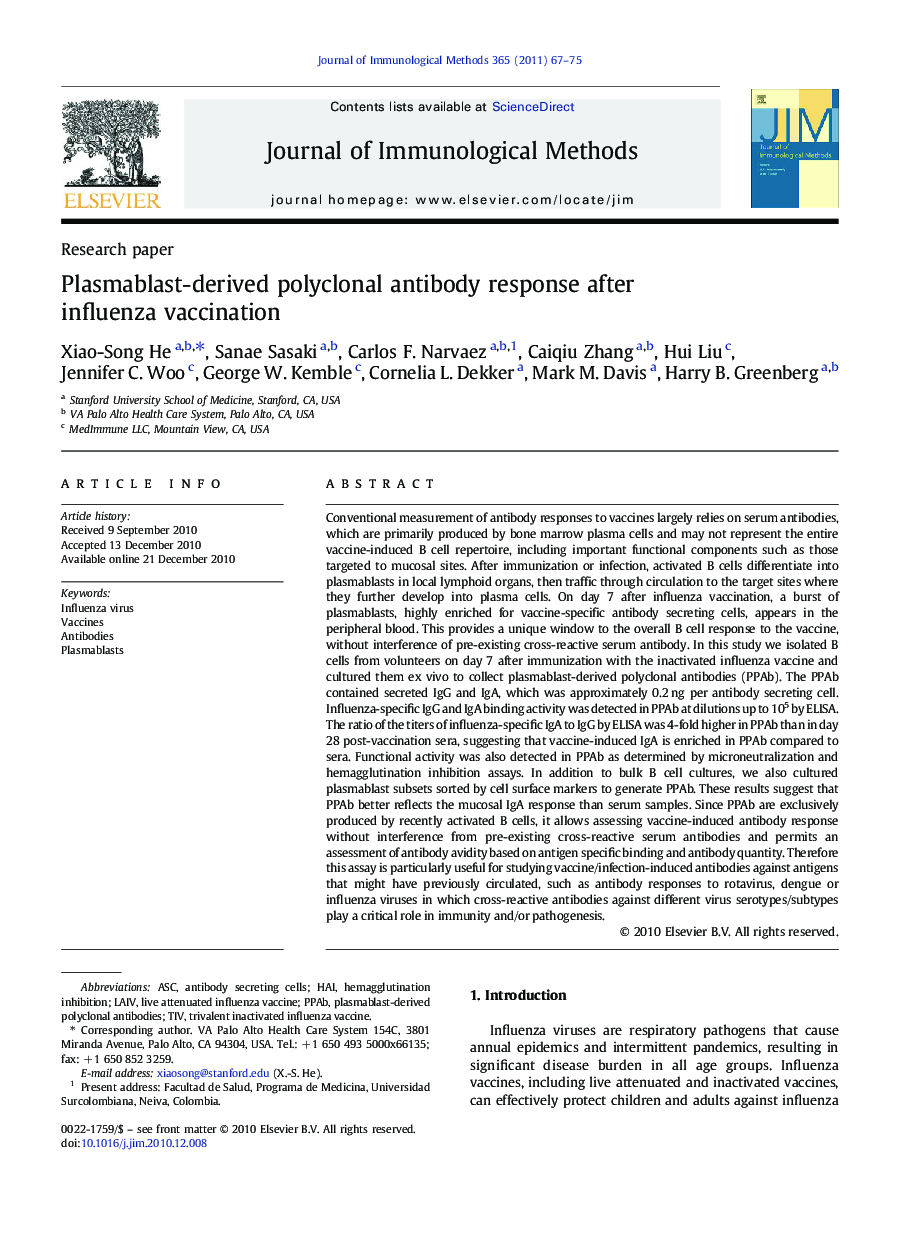| کد مقاله | کد نشریه | سال انتشار | مقاله انگلیسی | نسخه تمام متن |
|---|---|---|---|---|
| 8419637 | 1545742 | 2011 | 9 صفحه PDF | دانلود رایگان |
عنوان انگلیسی مقاله ISI
Plasmablast-derived polyclonal antibody response after influenza vaccination
دانلود مقاله + سفارش ترجمه
دانلود مقاله ISI انگلیسی
رایگان برای ایرانیان
کلمات کلیدی
ASCTIVHAILAIVantibody secreting cells - آنتی بادی ترشح سلول هاantibodies - آنتی بادی هاhemagglutination inhibition - مهار هموگلوبینVaccines - واکسنTrivalent inactivated influenza vaccine - واکسن آنفلوآنزا غیر فعال شده سه گانهlive attenuated influenza vaccine - واکسن آنفولانزای انسدادی زندهInfluenza virus - ویروس آنفولانزاPlasmablasts - پلاسمابلاست ها
موضوعات مرتبط
علوم زیستی و بیوفناوری
بیوشیمی، ژنتیک و زیست شناسی مولکولی
بیوتکنولوژی یا زیستفناوری
پیش نمایش صفحه اول مقاله

چکیده انگلیسی
Conventional measurement of antibody responses to vaccines largely relies on serum antibodies, which are primarily produced by bone marrow plasma cells and may not represent the entire vaccine-induced B cell repertoire, including important functional components such as those targeted to mucosal sites. After immunization or infection, activated B cells differentiate into plasmablasts in local lymphoid organs, then traffic through circulation to the target sites where they further develop into plasma cells. On day 7 after influenza vaccination, a burst of plasmablasts, highly enriched for vaccine-specific antibody secreting cells, appears in the peripheral blood. This provides a unique window to the overall B cell response to the vaccine, without interference of pre-existing cross-reactive serum antibody. In this study we isolated B cells from volunteers on day 7 after immunization with the inactivated influenza vaccine and cultured them ex vivo to collect plasmablast-derived polyclonal antibodies (PPAb). The PPAb contained secreted IgG and IgA, which was approximately 0.2Â ng per antibody secreting cell. Influenza-specific IgG and IgA binding activity was detected in PPAb at dilutions up to 105 by ELISA. The ratio of the titers of influenza-specific IgA to IgG by ELISA was 4-fold higher in PPAb than in day 28 post-vaccination sera, suggesting that vaccine-induced IgA is enriched in PPAb compared to sera. Functional activity was also detected in PPAb as determined by microneutralization and hemagglutination inhibition assays. In addition to bulk B cell cultures, we also cultured plasmablast subsets sorted by cell surface markers to generate PPAb. These results suggest that PPAb better reflects the mucosal IgA response than serum samples. Since PPAb are exclusively produced by recently activated B cells, it allows assessing vaccine-induced antibody response without interference from pre-existing cross-reactive serum antibodies and permits an assessment of antibody avidity based on antigen specific binding and antibody quantity. Therefore this assay is particularly useful for studying vaccine/infection-induced antibodies against antigens that might have previously circulated, such as antibody responses to rotavirus, dengue or influenza viruses in which cross-reactive antibodies against different virus serotypes/subtypes play a critical role in immunity and/or pathogenesis.
ناشر
Database: Elsevier - ScienceDirect (ساینس دایرکت)
Journal: Journal of Immunological Methods - Volume 365, Issues 1â2, 28 February 2011, Pages 67-75
Journal: Journal of Immunological Methods - Volume 365, Issues 1â2, 28 February 2011, Pages 67-75
نویسندگان
Xiao-Song He, Sanae Sasaki, Carlos F. Narvaez, Caiqiu Zhang, Hui Liu, Jennifer C. Woo, George W. Kemble, Cornelia L. Dekker, Mark M. Davis, Harry B. Greenberg,